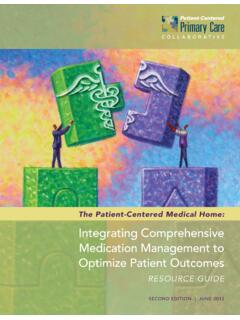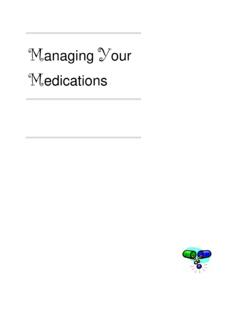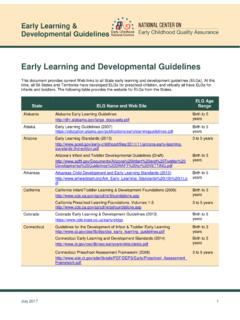Transcription of A 50-State Review of Value-Based Care and Payment Innovation
1 Research Study Value-Based Care in America: State-by-State A 50-State Review of Value-Based Care and Payment Innovation Commissioned by Change Healthcare 2019 Change Healthcare and/or one of its subsidiaries. All rights reserved. For reprint rights, please contact us. Value-Based Care in America: State-by-State 1. Table of Contents Key to Terms.. 4. Executive Summary.. 5. Report Foundation.. 7. Methodology .. 10. Defining Value-Based Payment .. 11. How Change Healthcare Can Help .. 12. State-By-State Summaries .. 13. Alabama .. 14. Alaska .. 15. Arizona .. 16. Arkansas .. 17. California .. 18. Colorado .. 19. Connecticut .. 20. Delaware .. 21. District of Columbia .. 22. Florida .. 23. Georgia .. 24. Hawaii .. 25. Idaho .. 26. Illinois.. 27. Indiana .. 28. Iowa .. 29. Kansas .. 30. Kentucky .. 31. Louisiana .. 32. Maine .. 33. Maryland .. 34. Massachusetts .. 35. Michigan .. 36. Minnesota .. 37. Mississippi .. 38. Missouri .. 39. Montana .. 40. Nebraska .. 41. Nevada .. 42. New Hampshire.
2 43. New Jersey .. 44. New Mexico .. 45. New York .. 46. Value-Based Care in America: State-by-State 2. North Carolina .. 47. North dakota .. 48. Ohio .. 49. Oklahoma .. 50. Oregon.. 51. Pennsylvania .. 52. Puerto Rico .. 53. Rhode Island .. 54. south Carolina .. 55. south dakota .. 56. Tennessee .. 57. Texas.. 58. Utah .. 59. Vermont .. 60. Virginia .. 61. Washington .. 62. West Virginia .. 63. Wisconsin .. 64. Wyoming .. 65. Table View of State-by-State Initiatives .. 66. About Change Healthcare .. 68. Value-Based Care in America: State-by-State 3. Key to Terms ACO: Accountable Care Organization APM: Alternative Payment Model CCO: Coordinated Care Organization CMMI: Center for Medicare and Medicaid Innovation CMS: Centers for Medicare & Medicaid Services CPC+: Comprehensive Primary Care Plus DSRIP: Delivery System Reform Incentive Payments EOC: Episodes of Care FFS: Fee-For-Service FQHC: Federally-Qualified Health Center HIE: Health Information Exchange LTSS: Long-Term Services and Supports MCO: Managed Care Organization MPC: Multi-Payer Collaborative P4P: Pay-for-Performance P4V: Pay-for-Value PCMH: Patient-Centered Medical Homes PMPM: Per Member, Per Month PSN: Provider Service Network RCO: Regional Care Organization SIM: State Innovation Models TCOC: Total Cost of Care Value-Based Care in America: State-by-State 4.
3 Executive Summary State Initiatives Continue to Drive Value-Based Care and Payment Reform Value-Based care (VBC) is being delivered across the New care and Payment models designed to improve quality and reduce costs are changing the way providers practice medicine and how they are compensated for their services. The federal government's role in driving these changes is highly visible due to the nationwide impact; however, state-initiated efforts are in many cases an equal if not surpassing force in transforming the healthcare industry and are the focus of this report. In 2017, Change Healthcare introduced its inaugural study, which highlighted state governments'. efforts to explore and implement VBC and reimbursement models. This study provides a state-by- state update of subsequent progress made in the past 18 months. Summary of Cumulative Findings 1. In just five years, there has been a seven-fold growth in the number of states and territories implementing Value-Based reimbursement (VBR) programs with a total of 48 implementing nationwide (includes the District of Columbia and Puerto Rico).
4 Number of States and Territories with VBR Programs States/Territories with VBR Programs 2. Well-developed, Value-Based Payment strategies have been implemented in six states for four years or longer, many with federal support. 3. Thirty-four states have initiatives two years or more into implementation. 4. Eight states are in the early stages of development. 5. Four states have had little-to-no Value-Based Payment (VBP) activity. 6. Among states pursuing Value-Based care initiatives, half of the programs are multi-payer in scope. 7. As with the federal government, 23 states have established Value-Based Payment targets or mandates that payers and providers agree to achieve. 8. Twenty-two states have adopted or are considering adoption of Accountable Care Organizations (ACOs) or ACO-like entities to help manage costs and deliver better care, and 16 states have adopted or are considering adoption of episodes of care (EOC) programs. 9. Many states have used Value-Based Payment reform to engage with healthcare stakeholders in the redesign of the state healthcare system, identifying unique and innovative strategies that work for their state healthcare markets.
5 Value-Based Care in America: State-by-State 5. What's New More than 20 states have evolved their Value-Based care efforts since the prior study. For detailed descriptions of each state's initiatives, refer to the narrative for each state. Comprehensive Primary Care Plus (CPC+). Since 2017, 18 regions have implemented Comprehensive Primary Care Plus (CPC+), a medical home model that seeks to strengthen primary care by reforming care delivery and multi-payer Payment . CPC+ includes two primary care practice tracks with incrementally advanced care delivery requirements and Payment options. To learn more about this program visit the CMS Website on the CPC+ Program. States Leading the Transition Overall, three states stand out for their breadth of initiatives, embrace of Payment models that involve shared risk, and willingness to test innovative strategies. These states include: New York, which through its SIM grant and demonstration waiver from the Centers for Medicare and Medicaid Services (CMS), has tested a Medicaid pay-for-performance (P4P) Payment model and risk-sharing arrangements with managed care organizations (MCOs), in addition to various VBP pilots focusing on maternity care, HIV/AIDS, and integrated primary care.
6 Pennsylvania, whose efforts began in 2013 and have included complementary strategies for achieving reform such as multi-payer EOC payments for acute care; global payments for enhanced primary care through patient-centered medical homes (PCMHs); and a global budget for rural hospitals. The state also required MCOs to shift 30% of their payments into APMs by 2019. Vermont, an early adopter, began its transition efforts in 2011, when it initiated a PCMH strategy. Since then, the state has deployed several VBP strategies including an all-payer ACO model, EOC. for the Medicaid population, and Health Homes. For a snapshot view of state VBC efforts, please see the table on page 66. Value-Based Care in America: State-by-State 6. Report Foundation It has been nearly a decade since Don Berwick and his colleagues at the Institute for Health Improvement introduced the concept of the Triple Aim . to the healthcare policy In the article that helped launch the current Payment reform movement, the authors argued that the goal of the health system should be to achieve three interdependent outcomes: improved care for individual patients, improved population health, and reduced costs of care.
7 A central and necessary step to achieving the Triple Aim, they posit, is a shift away from the thinking that more care is better, and toward better alignment of the care and treatment Payment systems with better outcomes and improved health. Instead of simply increasing reimbursements, Payment structures should reward the most effective treatment decisions properly coordinated to maximize the quality of outcomes. What emerged in years since is a concerted effort among commercial and public payers who, in partnership with providers, are moving away from fee-for-service to Value-Based Payment arrangements. Among public payers, Medicare has taken a leadership role in implementing value- based payments, setting a goal in 2014 of tying 30% of Medicare payments to value by 2016 and 90%. by This goal has led to the rollout of numerous Value-Based Payment initiatives by the Centers for Medicare and Medicaid Services Innovation Center (CMMI), including the creation of the Health Care Payment & learning Action Network (HCP-LAN), a public-private partnership aimed at spurring Payment Innovation in the healthcare system at-large.
8 Congress also has passed major legislation (PAMA and MACRA) that require Value-Based Payment in Medicare. While Medicare is obviously an influential player in the healthcare system, states retain significant authority over their regional healthcare market and can play a critical role in moving healthcare toward value. Medicaid now provides coverage for 21% of the covered lives in the , behind employer-based coverage at 49% but ahead of Medicare at an estimated 14%.3 In addition, individual states have authority over both Medicaid operations and private insurance markets within their jurisdiction. With recent changes to the Medicaid and Children's Health Insurance Program Managed Care Rule, states now have the affirmative authority to require Medicaid Managed Care Organizations (MCOs) in their state to implement Value-Based Payment If they choose to exercise this authority, states have significant power to move their state health insurance markets toward Value-Based Payment reform.
9 Not surprisingly, a Review of state Value-Based Payment reform initiatives demonstrates significant variation in approach, due in part to factors motivating the shift to value. State Payment reform has historically been influenced by factors including state-focused CMS initiatives, state budget challenges, and state policymakers' interest in healthcare Innovation . Two CMS sponsored programs the State Innovation Model (SIM) grants and the Delivery System Reform Incentive Program (DSRIP) waivers for Medicaid require states as a condition of participation to develop a Payment reform strategy. SIM grants were released in two rounds beginning in 2013, and in two tracks, known as Design and Test. 5 Design grants, which supported more than 20 states in developing a State Innovation Plan, were typically about a year in duration and ranged from $1-$3. million. Test grants support implementation of the state-designed Innovation plan, and amounted 1 Berwick DM, Nolan TW, Whittington J.
10 The Triple Aim: Care, Health, And Cost. Health Affairs, May 2008, 27:3. 759-769. 2 Centers for Medicare & Medicaid Services. Better Care. Smarter Spending. Healthier People: Paying Providers for Value, Not Volume. January 1, 2015. 3 Health Insurance Coverage of the Total Population, Kaiser Family Foundation, 2017. 4 Centers for Medicare & Medicaid Services, Medicaid and CHIP Managed Care Final Rule, April 2016. 5 State Innovation Models Initiative: General Information. Centers for Medicare & Medicaid Innovation Center. Value-Based Care in America: State-by-State 7. to tens of millions of dollars per state over a three- to four-year period. In total, 17 states benefited from Test grants, including 11 that are still actively engaged in completing the second round. The SIM. program requires a multi-payer reform focus, while DSRIP focuses on Medicaid. The DSRIP has been implemented in 10 states and allows for an incentive Payment through Medicaid for providers that meet certain performance In addition to the programs above, a number of states have been approved to participate in Comprehensive Primary Care Plus (CPC+), a medical home model that seeks to strengthen primary care by reforming care delivery and multi-payer Payment .












